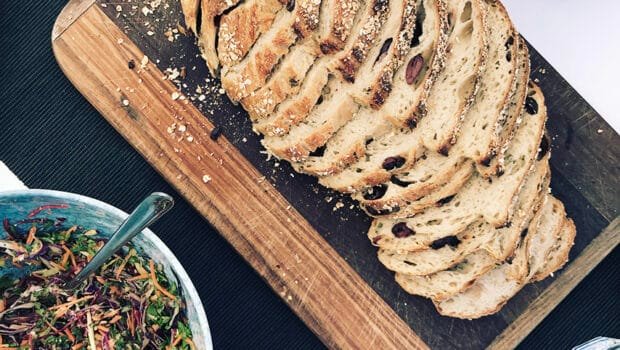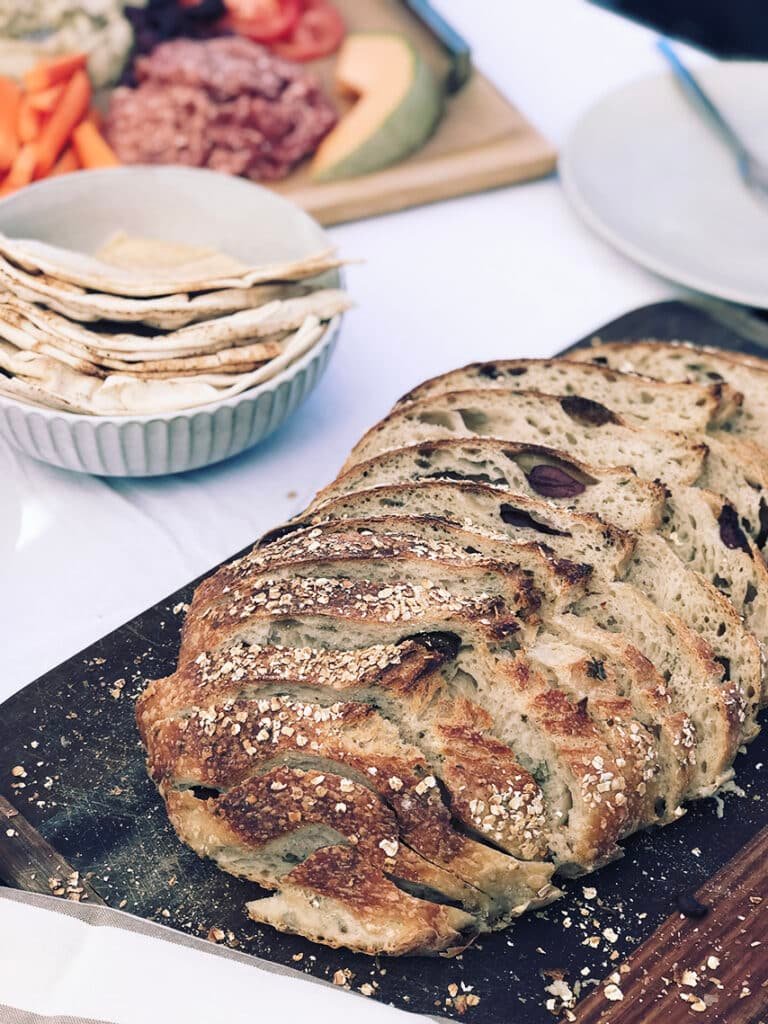CONTENTS Equipment | Ingredients | Dough & Rise | Shape & Refrigerate | Bake
After 18 months of making flat sourdough bread and not knowing why my sourdough was flat, it’s my passion to help you make sourdough bread that works!
I want you to make sourdough bread that you’re proud of!
The process is simple, but it’s specially designed to avoid sourdough that’s flat. The hydration, method and tips along the way are the accumulation of making sourdough bread for almost a decade and half, and it still makes me smile when I get out of bed!
This recipe is can be made using the low-maintenance and Pantry Sourdough Starter versions, Just add the quantity of olives and thyme from this recipe into the dough when you mix it. Also add the extra 3g of salt.
If you need to buy sourdough starter or want to try some different sourdough starters, check out my shop.
If you’ve had trouble with flat sourdough bread
The specific ratios of water to flour and sourdough starter, simple techniques and other hacks have been purposefully put together in this recipe to help avoid baking sourdough bread that’s flat. It’s also designed to make the entire sourdough bread process easier and less time-consuming. Another good thing is that you will only need tools and equipment that you will probably already have at home.
If you have tried making sourdough bread and it’s been emerging flat from the oven, this is the recipe for you!! I also recommend you read Waging war on flat sourdough bread and 4 key reasons why your sourdough bread is flat so that you can make sure that your flour and/or sourdough starter are not one of the issues. If they are, they need to be sorted first. This is a miracle-working recipe but it’s dependent on proper flour and a healthy sourdough starter.
To make your no-knead sourdough, you will need an active, fed sourdough starter that has, just now, doubled from its last feed.
PREP TIME: 15 hours to 1.5 days based on the temperature of your kitchen (Details to help are included in the recipe)
TOTAL HANDS-ON TIME: Less than 10 minutes (excluding baking)
Testing the temperature of your kitchen
To test the temperature of your kitchen, a small room thermometer is super helpful. You can also use the reading on your air conditioner.
For more information read: How can I work out the temperature of my kitchen?
Or go with the flow.
Knowing the temperature of your kitchen (or warm place) is helpful in estimating how long it might take your sourdough to double. It’s especially helpful when you are not available for periods of time, such as a workday or going to bed overnight. Knowing the temperature helps you confidently leave your sourdough knowing it won’t double before you can get back to it. Knowing the temperature helps you hack doubling times when needed.
Equipment
Room temperature thermometer (optional)
Digital scales
2 Large non-metallic mixing bowls
Tupperware container (optional)
Spatula or spoon
Cling wrap
Baking paper (parchment)
Spray oil
Sharp knife
Oven gloves or very thick cotton tea towel
Dutch oven / casserole dish or pizza stone or fake both
Ingredients ~ per loaf
180g Active sourdough starter (6.35 oz)
415g Bread Flour* (14.65 oz)
300g Water** (10.58 oz)
12g Salt (0.42 oz)
1 Cup Pitted Kalamata Olives
1/4 Cup Fresh Thymne Leaves stripped from the stem (I Use pizza thyme)
2 Tablespoons of Rolled Oats (whole or quick cut)
If you’re interested read Why I use weight to measure
MAKING MORE THAN ONE LOAF
To make two loaves, you can double all ingredients and mix as one dough. However, even though there is no kneading, it can be a little difficult to handle. I still make each one separately for ease.
*Flour, room temperature and time will make or break your loaf. Seriously! Flour should contain 13% protein. Take a moment to read the big deal about flour and sourdough bread and more importantly where to get it in Australia. It’s super easy to get the right flour!
**Use warm for a faster rise, use room temperature water for a slower rise such as during a workday or overnight.
Dough & Rise
1. Scoop the sourdough into your mixing bowl. Add 9g of salt (0.32 oz) and 300g of water (10.58 oz) directly to the sourdough starter and stir vigorously to dissolve all solids.
2. Add 415g of bread flour (14.64 oz) to the water and sourdough starter. Mix well to combine. Add the 1 Cup Olives, 1/4 Cup thymne leaves
3. Squeeze the mix (like a sponge) for 1-2 minutes using your hands. This will help ‘push’ water into the flour and hydrate it. Clump the dough into a ball shape and wash your hands.
4. Cover the bowl* with cling wrap** and leave it somewhere where the temperature will be fairly stable. Follow these time-frames for the temperature of your kitchen at the moment:
– 18°C or below (64°F) : 12+ hours^
– 19-23°C or below (65-74°F): 8-10 hours^
– 24°C or above (75°F) : 4-5 hours^
As you approach the end of the rise time, check every now and then to see if it has doubled in size, especially if you just guessed the temperature. Your dough will be ready to shape when it’s nearly double it’s original size, puffy, and a number of bubbles may be poking through the surface or seen on the side. (Using a glass bowl makes it easy to see but not essential!)
*If you don’t mind an extra step, using a clean, lightly oiled bowl stops the dough from sticking to the bowl during the rise. When you tip the dough out later, you will keep all the lovely air pockets that form. When dough sticks to the bowl, it stretches as it releases and tears the air pockets that help it rise.
**Using a clear reusable shower cap over your bowl, instead of cling wrap, helps put less plastic in landfill.
^If your sourdough starter is really active, this may too long. When making this for the first time at each temperature, check your dough when it’s been rested for 80% of the suggested time. If it’s almost doubled, then your starter is really active and you can move to Shape & Refrigerate
WATCH THIS STEP
Shape & Refrigerate
1. Lightly oil your bench-top and gently tip out your dough. If you made enough for two loaves and made it as one dough, use a dough scraper or firm plastic spatula, cut the dough into two equal halves.
Work gently from here. You want to keep as many air bubbles in your dough as possible.
2. Using wet hands, pinch one side of the dough and stretch it up towards the ceiling, then fold across the dough to the other side. Pinch next to where you pinched last time and repeat. Work your way around the dough, overlapping the previous fold through the centre each time. This process is like wrapping a present tightly. Pull and stretch 12-14 times until your dough becomes tight. It will start to resist as you work until it becomes too difficult. Then you know you’re done!
3. Grab a piece of baking paper. Some flours stick to even non-stick paper. You may like to lightly oil the paper first. Gently place your dough onto the paper with the seam side facing down.
Optional step: Place your dough onto the baking paper with the seam side up instead. If you do this you will flip it over before baking. Doing this allows air bubbles to gather underneath the top surface while the dough is in the fridge and when the loaf is flipped, they moved to the bottom of the loaf, forcing them to rise to the top again during baking, improving oven spring.
4. Use the baking paper to lower the loaf into a large Tupperware container or oversized bowl.
5. Seal with the Tupperware lid or cling wrap and place into your refrigerator for a minimum of 10 hours, and up to 24 hours.
That’s it until you bake!
WATCH THIS STEP
Bake
Before following the next step, you need to choose your baking method:
Dutch oven or casserole dish
Pizza stone
Faking it – Baking without a Dutch oven or pizza stone
1. Preheat your oven for 45 minutes to 1 hour at 250°C (482°F). Remember to add your Dutch Oven, Pizza Stone or chosen bake-ware. The heat absorbed during this time is super important in helping the loaf rise.
2. After the oven has been on for an hour, take your loaf out of the fridge. Lift it from the container using the baking paper and place it on the bench.
Optional step: If you placed your loaf seam side up in the previous step, pick up the dough and gently turn it upside down*. The dough will be firm enough to handle since it is cold. Don’t do this if you skip the refrigerator method – either don’t flip it or use a banneton and baking paper to aid flipping it. Once flipped, place it back onto your baking paper. What was the bottom of the loaf should now the top. If the loaf feels very soft and your hand is starting to sink into it, DO NOT FLIP. The dough is overripe and your hand will degas it. Leave it and consider not slashing it. Bake otherwise as usual. If your loaf sticks to the baking paper when you try to flip it, your flour may have a low hydration threshold, meaning it takes on water easily. Spelt is a good example. Pre-oiling the paper helps with this. Don’t flip it this time, you risk deflating your loaf trying to remove it from the paper. Bake as normal (including slashing). If you want to try this step, add 40g less water next time to make the dough less sticky.
Your loaf will likely look flat, with a large top and small bottom. Don’t worry! It will magically transform in the oven.
* The sourdough will be firm enough to handle because it’s cold, don’t do this if you skip the refrigerator method.
3. Brush your sourdough loaf generously with water** and cover with the rolled oats, lightly patting to help them stick to the surface.
4. Using the sharpest knife you have or a razor blade move deeply, quickly and confidently on an angle through the loaf. If you go slow, the knife will drag the dough. This helps control the oven spring and make your loaf look professional.
5. To bake your sourdough bread follow the method chose:
Dutch oven or casserole dish
Pizza stone
Faking it – Baking without a Dutch oven, casserole dish or pizza stone
5. Your loaf is cooked when it sounds hollow as you knock it on the bottom with your knuckles. (Like knocking on a door.)
6. Celebrate & tag us!
#mysourdoughlovestory
#beautifullivingmadeeasy
@beautifullivingmadeeasy
*During proofing the top of the sourdough (exposed) hardens a little, which inhibits rising, and the air bubbles float to underneath the surface. Turning your sourdough over means the hardened dough becomes the base of your loaf, the fresh top with spring more easily, and all the air bubbles (now on the bottom) will rise through your loaf as it bakes.
**Wetting your sourdough loaf stops the crust forming early, restricting the size of the loaf. It also helps to add gloss to the crust and make it crunchy.
Making more than one loaf at a time
Making BLME Sourdough in a cool kitchen (23°C (74°F) or below)
Bread flour storage ~ made easy
Make your own BLME Bread Mix


